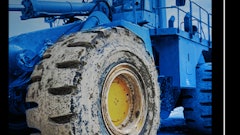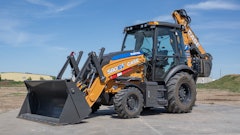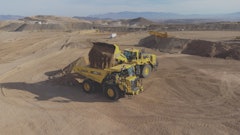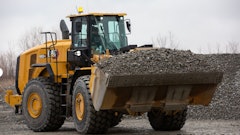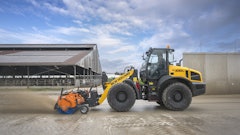
Payload management systems speed the loading process while preventing overloaded trucks. The goal is to increase cycle times while maximizing payload. “Payload weighing systems can be used to maximize production and revenue by increasing efficiency and allowing more trucks through the facility,” says Grant Van Tine, solutions marketing manager, John Deere.
Two common scenarios can occur when payload weighing systems are not used. “Once loaded, when a customer truck reaches the scale, it could be under or over its target weight. If overweight, the truck will have to dump excess material, which will then need to be stockpiled by the loader. If underweight, the truck will either leave as-is or will have to get topped off,” Van Tine points out. “Both scenarios cause disruptions, inefficiencies, potential delays for other trucks waiting to be loaded and lost revenue. Payload weighing systems ensure each truck is loaded to its target weight at the pile, maximizing efficiency and revenue per truck.”
Payload management systems eliminate the guesswork. “It would be just guesswork without a scale. Payload management systems give visibility to the loader operator so that he/she knows the exact weight of each bucket being loaded onto the truck,” says Sam Shelton, marketing manager, Hitachi Construction Machinery Loaders America. “It also enables the loader operator to load with confidence that he/she will load accurately, optimizing the company’s profitability and without the fear of overloading the truck.”
When operating over public roads, there are legal considerations. “Overloading a truck can lead to fines if the truck driver is unaware (which can happen with today’s digital invoicing), or the truck must pull over and dump to get to legal weight,” says Shelton. “Neither is the desirable customer service experience.”
Payload Management is a Must Have
“Get payload if you do not have it, and if you have it, use it,” advises Jason Hurdis, global market professional, Caterpillar. “Payload systems can save so much money — faster truck loading, less truck recycle, reduced operator fatigue, less maintenance — for any operation. In my opinion and experience, a payload system is vital to optimize wheel loader and operator performance. Without a payload system, everything is a guess or feel. If you can measure something, you can track it. If you can track it, you can manage it. If you can manage it, you can improve it.”
Eric Yeomans, product manager, wheel loaders, Volvo Construction Equipment, adds, “Make sure fleet managers and operators understand what the systems offer, how to interpret the data and how to respond.” Review the data and use it as training material. “For example, if an operator is consistently under loading, take the opportunity to educate him or her on the issue, allowing them to grow into a more efficient wheel loader operator.”
It is all about speed and accuracy. “The faster the material is moved, the faster the trucks or trains can leave, thus more trucks can be loaded in an hour, day or week, increasing production for the site,” says Hurdis.
“The payload meter system can be used to ensure all off-road haul trucks are being loaded to their rated capacity,” says Robert Hussey, product marketing manager, Komatsu America. “For example, if a haul truck has a rated payload of 101.6 tons (such as the Komatsu HD785-8), the payload meter system can be set in subtraction mode with the total tons at 101.6 tons. As the operator loads the truck, the payload in each bucket will be subtracted from the total tons, enabling the operator to accurately load the haul truck to its rated load. When the truck is loaded, the operator can simply press and hold the payload meter reset switch located on the bucket control lever. This will reset the total tons to 101.6 U.S. tons and the system will be armed for the next haul truck loading cycle.”
Customers should ensure they understand how the system functions. “For example, the customer needs to know the conditions necessary to both start and stop a successful measurement,” says Adam Braun, product marketing manager, Komatsu America. “Such a basic knowledge can prevent frustrations when an operator is using a system for the first time.”
Taking full advantage of the features a payload system offers allows companies to gain the most benefit. “Most payload weighing systems provide detailed data tracking capabilities,” says Van Tine. “The John Deere payload weighing system for the 744L, 824L and 844L wheel loaders is capable of tracking individual operator grand totals, as well as totals by customer, job and product type. This data can then be offloaded onto a USB drive or through a telematics system to be imported into other systems.”
He adds, “Features like dynamic weighing and the ability to tip-off at the pile or the truck allow loader operators to accurately achieve target weights quickly and consistently. Dynamic weighing calculates weight while in motion, so the loader operator does not need to stop to capture the weight of each bucket load. Quick keys on the display can be set up for specific customers to automatically pull up preset target weights for a particular customers’ trucks. There are multiple settings available that can be set up and saved to an individual operator’s preference.”
Operators need to understand how to properly utilize the functions on the particular payload system being utilized. Consider the addition and subtraction functions on the Komatsu payload management system:
When in addition mode, the payload meter adds each recorded payload to a running total. This total can be used to track how much material has been loaded into a haul truck and reset when the truck is fully loaded. It can also be used to track the total amount of material loaded from an area of the site.
When in subtraction mode, operators enter the total amount of material they want to load. Each time they complete a pass on a truck, the payload from that bucket is subtracted from the total amount. This function can be used to track total tonnage moved from an area of the site and indicate when the wheel loader can move to another area.
For both addition and subtraction mode, five different target materials can be selected (A, B, C, D, E). These target materials can be linked to different areas of the site, enabling operators to track their productivity in each area. The selectable target material function can help operators achieve more accurate material blending ratios.
New features are constantly being added. “The Load Meter system that was recently introduced with the [Komatsu] WA475-10 features new functions not previously available, such as a dump monitoring function that allows for real-time monitoring of remaining material weight in the bucket (tip-off),” says Braun. “There is also an empty bucket calibration feature that allows the operator to easily calibrate the weight of the empty bucket to ensure the system has proper accuracy throughout the work day.”
Payload Management Systems cannot compensate for operator skill. “You still need a skilled operator — they can’t rely 100% on the tech,” says Yeomans. But these systems can be utilized as training tools. “A coaching feature can help operators maximize their productivity and fuel efficiency. Operators need to understand that ground conditions, inclines and other project characteristics factor into choosing the right modes. That’s where the operator coaching feature can help.”
The Operator Coaching feature on Volvo’s Load Assist provides real-time guidance on idling, braking, throttling and engaging the transmission lockup. “This helps operators know how their actions influence the machine and helps managers identify opportunities for additional improvement,” says Yeomans.
Calibration Ensures Accuracy
Payload systems need to be calibrated to ensure accurate data. “Like any machine or software, payload needs maintenance,” says Hurdis. “The most frequent maintenance for payload systems is calibration. Some systems have full calibration that could take anywhere from 5 to 15 minutes. Our systems have full and simple calibration features that reduce the timeframe and allow for improved accuracy by allowing the operator to simply calibrate the system to known outbound truck weights from the scalehouse.”
Braun adds, “The most important tip we can provide to our customers so they get the most out of the payload management system is to keep the system calibrated following the proper procedures in the operating manual for their equipment. In order to ensure proper function on the load meter, Komatsu recommends that calibration occurs at a minimum of every three months, or after any component of the system is replaced.”
Telematics data integration adds value
Telematics systems can prove useful with payload systems. “Use off-board data reporting such as VisionLink or other systems to track material flow, tonnage and other metrics,” advises Hurdis. “The power of these reports and data is extremely helpful in tuning any operation for maximum efficiency and profitability.”
OEM systems can often integrate payload with onboard telematics. “One of the differentiators is that Load Assist is integrated with the machine’s computer so you can monitor certain information remotely, like total gallons of fuel vs. production, production tons per hour, tons per gallon of fuel, etc., via the telematics production reports,” says Yeomans. Data can also be exported via a USB or sim card, or by tethering to the cloud.
In a pit extraction application, Hitachi’s LOADRITE system reports on extraction tons per hour (tons per each haul truck loaded). “This is useful because the quarry supervisor can see if the extraction — load and haul process — tons per hour is in line with the crusher tons per hour,” notes Shelton. “If your primary crusher is designed for 500 tons per hour and your extraction process is doing 300 tons per hour, then you will see the performance gaps and enable optimization/maximization.” Without a payload management system, you would have no idea.
Aftermarket offers high-end options
There are several aftermarket suppliers offering high-end payload systems that are very precise and produce quality data that can drive efficiency across the operation.
Trimble LOADRITE ranks among the high-end aftermarket solutions. “Hitachi Wheel Loaders has partnered with Trimble LOADRITE,” says Shelton. “The Hitachi LOADRITE system provides insights, not just reporting. This is a great fit with our after sales solutions’ focus, providing data and interpretations that lead to increased efficiency and performance.”
Consider a quarry application. “Trimble’s solutions combine loader scales, excavator scales, haul truck monitors and conveyor scales as inputs to the Trimble cloud system, where the customer can visualize and gain insights into their quarry extraction, processing and loadout,” notes Shelton. “Trimble highlights KPIs such as tons per hour of each process, tons sold per customer, by date, etc. This data provides much more insight than the data ‘20t on a truck.’”
The benefits of integrated systems
Systems developed by the wheel loader manufacturers have the capability of interfacing with existing systems on the machines. This level of integration can add to the overall productivity.
“There are three main benefits to selecting an OEM payload system,” says Hurdis. These include:
System integration. Who knows the sensors, hydraulic systems, computer systems, wire harnesses and other components required for accurate and repeatable system operation better than the OEM?
Service, repair and support. OEM solutions also offer service and repair benefits. The same technician that services the machine can also service or repair the payload system, offering the customer a one-stop shop for help.
Visibility. Today’s operator stations and cab have a lot going on in them. The operator has more settings and switches than even before. OEM systems allow for payload systems to operate on existing cab monitors or displays. This eliminates another display being mounted in the cab that can affect visibility.
OEM-based payload systems can also communicate with other vehicle systems. “One major difference between the John Deere payload weighing system on the 744L, 824L and 844L wheel loaders and aftermarket systems is that the John Deere solution also comes with an autolube system,” says Van Tine. “Lubrication is key to payload weighing system accuracy and autolube ensures the machine is regularly greased during operation.”
Volvo recently introduced five new Load Assist apps for tire pressure monitoring, mapping, performing calculations, note taking and weather monitoring. “These make maintenance and everyday life easier for fleet managers and operators, which trickles down to their productivity.” ET

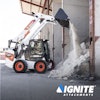


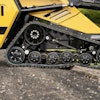

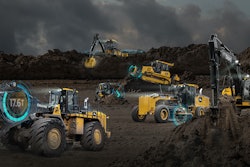
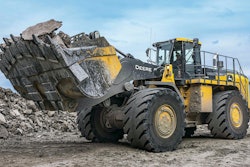

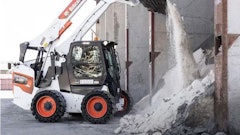


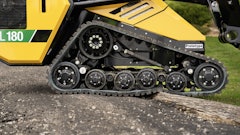
![Hcm Ax Landcros Dual Branded Logo[25]](https://img.forconstructionpros.com/mindful/acbm/workspaces/default/uploads/2025/11/hcmaxlandcros-dual-branded-logo25.Qhg3vUCjoK.jpg?ar=16%3A9&auto=format%2Ccompress&bg=fff&fill-color=fff&fit=fill&h=135&q=70&w=240)
